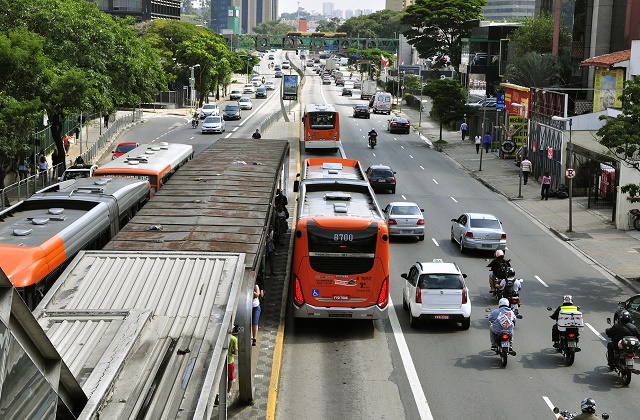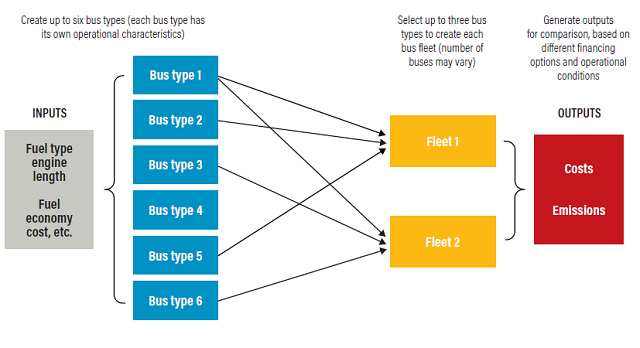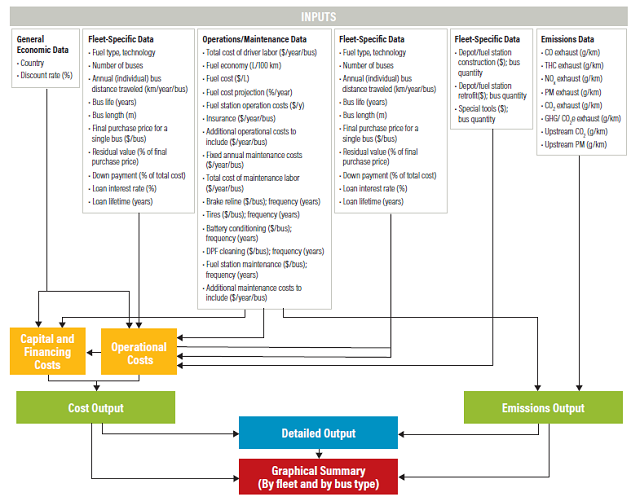
São Paulo, Brazil, explores the promise of electric buses as a means to decrease its transport-related emissions by 2038. Photo by Mariana Gil/WRI Brasil
Buses are one of the major sources of emissions in many cities, and they are undergoing a quiet revolution. A confluence of improved technology and increasing demand, driven by air pollution that is getting harder to ignore and more stringent carbon reduction targets, means more cities than ever are investing in clean bus technologies. But with growing demand are more questions about the right technologies and business models for long-term success.
It can be daunting for cities to commit to vehicles they have no experience with, not to mention the high upfront procurement costs of pure battery electric and hybrid electric buses compared to traditional fossil-fueled buses. Distribution of electric buses to date has been uneven. In many cities, a lack of high-quality data and context-specific models leave operators feeling like investment is a shot in the dark.
To lower the threshold for adopting clean bus technologies, it’s important for operators and transit agencies to have useful, high-quality data from existing clean bus fleets, a clear breakdown of the total costs of ownership, and a more comprehensive vision of the whole process.
In the Costs and Emissions Appraisal Tool for Transit Buses (the CEA Tool), WRI hopes to help answer some of these questions. The new tool developed by WRI Ross Center, already used by São Paulo and other cities, is an accessible, Excel-based method for analyzing the lifetime costs and emissions of different bus types to help cities navigate the transition to clean buses.
What’s in the CEA Tool?
The CEA Tool is intended to help bus operators and transit agencies make informed decisions about alternative bus types and determine whether the transition to a cleaner fleet is financially viable and worthwhile based on expected emissions reductions. It can compare electric bus options, as well as natural gas-fueled buses, and the value of retrofits for existing diesel fleets, like better exhaust filters.
A custom Excel sheet allows users to compare the costs and emissions reductions of two bus fleets, each composed of up to three bus types. Bus types can differ in terms of fuel type, the technology used to achieve different emissions standards, and length.

Users can input fuel and vehicle unit cost data for a specific city or country, or they can choose from default data from Brazil or the United States. Based on the data, the CEA Tool calculates the costs and emissions of each bus type, and the total costs and emissions of each fleet. Capital expenses (upfront procurement costs, financing and depot/infrastructure costs), as well as operating expenses (operations, fuel, maintenance and overhaul/retrofits) are included, helping cities understand the total cost of ownership over the life time of different vehicle choices.
The emissions calculations are based on simplified functions, using vehicle distance traveled, fuel economy and emission factors. Ideally, emissions factors should be based on operating speeds, taking road congestion and other conditions into account. But there is little data available on all types of vehicles under different operating conditions. The emissions estimates are therefore based on general factors from lab testing. These can be updated, however, as better data become available, or replaced with local data.

New Plans for São Paulo
In 2018, WRI Brasil Ross Center applied the CEA Tool in São Paulo, the second-largest city in the Americas, and two more Brazilian cities. São Paulo had created a target to reduce major public transport-related emissions and pollutants by 100% by 2038. Reaching this target clearly requires increased adoption of cleaner buses, given the city’s 14,000-strong public bus fleet. However, the fleet is operated by private companies. To encourage more private operators to electrify their fleets, the municipal government asked WRI Brasil to help them better understand the environmental and economic impacts of new vehicles.
The first step was to obtain better local data, which proved more challenging than anticipated. There is little operational data for the city’s bus fleets, so WRI Brasil worked directly with the São Paulo transport agency to aggregate and obtain operational data from the fleet directly. We then used data from Santiago, Chile, which has the largest electric bus fleet outside China, and an extensive literature review to inform assumptions about electric, hybrid and other alternatives.
The second step was to create scenarios to help understand bus upgrade options. WRI Brasil worked with SPTrans, which manages the bus operators, to create scenarios using different bus fleets, costs and emissions. Twenty scenarios, one for each year from 2018 to 2038, were created with different fleet compositions. The CEA Tool showed that the 2038 scenario that achieved a 100% reduction of direct pollutant emissions reduction (CO2, PM and NOx) would involve a fleet of 98% electric buses and 2% trolley buses. It would also reduce total costs by 12% compared to renewing the fleet using typical diesel technologies.
Moving Beyond Myths
Operators in São Paulo are now in the process of considering which options, or combination of options, to propose to SPTrans, which will assess proposals with an eye toward meeting the city’s goal of zero emissions and pollutants from public transport by 2038.
There are still limitations to this analysis, including the availability of local data and the sophistication of the calculations. Cities are encouraged to use the CEA Tool as an initial step to understand the lifecycle costs and benefits of clean buses and input their own data to further tailor the model to local conditions. We are also working on an update that will add more operational data from electric bus fleets in China, and elsewhere that they are emerging. The next phase of the CEA Tool will also include social costs and benefits inputs to help local stakeholders better quantify additional gains from clean transport technologies.
The CEA Tool provides evidence for a data-driven discussion about real options with stakeholders like bus operating companies, transit agencies, and government officials to help break through initial, sometimes-flawed impressions and accelerate the transition to cleaner bus transit.
Xiangyi Li is a Research Analyst at WRI Ross Center for Sustainable Cities.
Eduardo Henrique Siqueira is an Urban Mobility Analyst at WRI Brasil Ross Center for Sustainable Cities.






